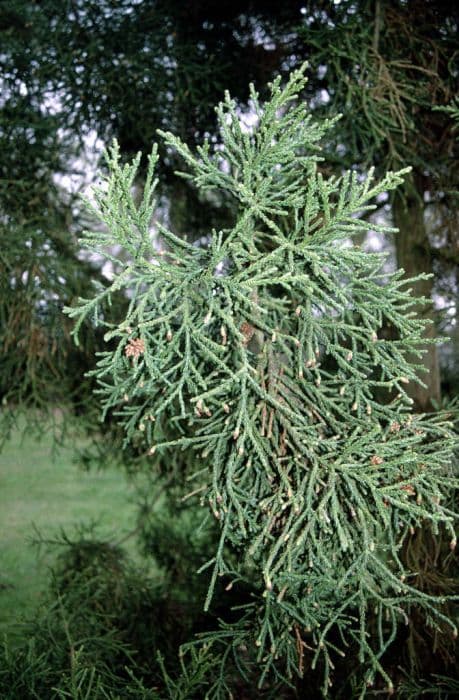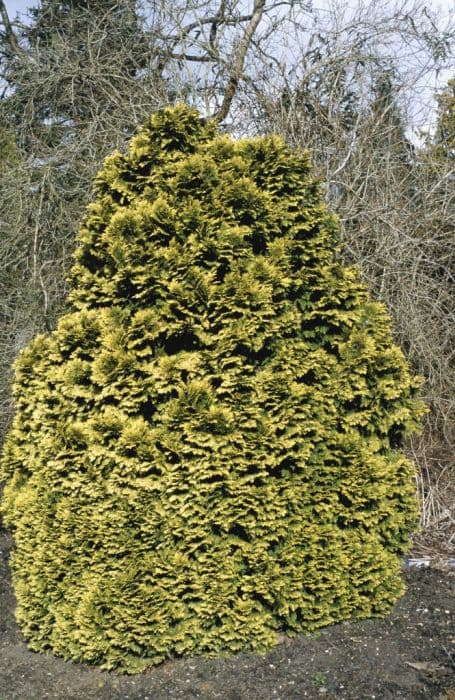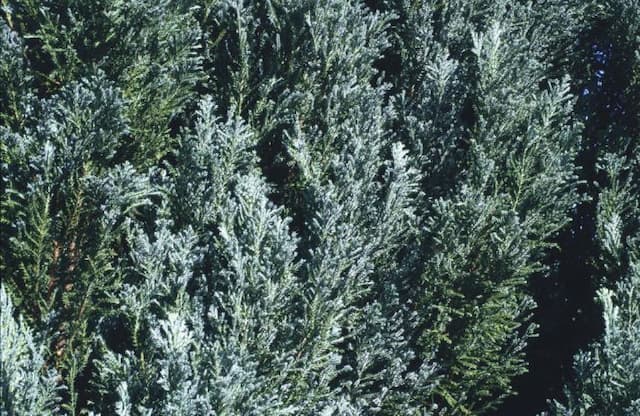Lawson Cypress Chamaecyparis lawsoniana











ABOUT
The plant commonly known as the Lawson's cypress is a coniferous evergreen, notable for its dense foliage and a conical shape. The leaves are arranged in flat sprays with a feathery texture, and the color can vary from a deep green to a blue-green hue, depending on the variety. Young leaves tend to be needle-like, while mature foliage becomes more scale-like. This plant produces small cones that are initially green and mature to a brown color as they age. The cones are typically less than an inch long and have a slightly woody texture. The bark on the main trunk of the Lawson's cypress is reddish-brown and often appears vertically fissured, giving it a rough texture to the touch. Overall, the Lawson's cypress has a lush, soft appearance, making it a popular choice for ornamental use in landscape design. It's commonly used as a feature plant or for creating hedges and screens due to its dense growth habit.
About this plant
 Names
NamesFamily
Cupressaceae.
Synonyms
Lawson's Cypress, Port Orford Cedar, Oregon Cedar, Lawson Cypress.
Common names
Cupressus lawsoniana, Chamaecyparis lawsoniana var. pendula, Cupressus lawsoniana var. pendula, Chamaecyparis lawsoniana var. erecta, Cupressus lawsoniana var. erecta, Chamaecyparis lawsoniana f. erecta, Chamaecyparis lawsoniana var. intermedia, Retinispora lawsoniana, Chamaecyparis erecta, Chamaecyparis lawsoniana var. glandulosa, Chamaecyparis lawsoniana var. plumosa, Chamaecyparis lawsoniana var. stricta, Chamaecyparis lawsoniana var. versicolor, Cupressus glandulosa, Cupressus lawsoniana var. alba, Cupressus lawsoniana var. argentea, Cupressus lawsoniana var. aurea, Cupressus lawsoniana var. glauca, Cupressus lawsoniana var. lobbii, Cupressus lawsoniana var. plumosa, Cupressus lawsoniana var. stricta, Callitropsis lawsoniana.
 Toxicity
ToxicityTo humans
The plant commonly known as Lawson's cypress is not known to be highly toxic to humans. However, as with many plants, certain parts may cause irritation or an allergic reaction if ingested or if they come into contact with the skin. It is generally advisable to avoid eating any part of ornamental plants due to potential adverse reactions. Ingestion of significant quantities could possibly lead to gastrointestinal discomfort or other symptoms, but severe poisoning is uncommon.
To pets
Lawson's cypress is also not highly toxic to pets, but as with humans, ingestion of plant parts can potentially lead to gastrointestinal irritation, including symptoms like vomiting or diarrhea. It is recommended to keep an eye on pets to prevent them from chewing on plants, particularly houseplants and landscaping, as even non-toxic plants can cause upset stomachs or other mild reactions in pets when ingested.
 Characteristics
CharacteristicsLife cycle
Perennials
Foliage type
Evergreen
Color of leaves
Green
Height
40 50 feet (12 15 meters)
Spread
10 15 feet (3 4.5 meters)
Plant type
Tree
Hardiness zones
5 8
Native area
North America
Benefits
 General Benefits
General Benefits- Ornamental Value: The Lawson cypress is widely used in landscapes for its attractive pyramidal shape, dense foliage and sometimes colorful cones.
- Habitat Support: It provides habitat and nesting sites for various species of birds and small mammals.
- Erosion Control: This plant's root system helps stabilize soil and prevent erosion, especially in hilly or sloped areas.
- Windbreak: The dense foliage of Lawson cypress makes it an effective windbreak, protecting areas from strong winds.
- Shade: It offers shade and cooler temperatures underneath its branches during hot weather.
- Sound Barrier: The tree can act as a sound barrier when planted in groups, reducing noise pollution from roads and urban areas.
- Wood Production: The wood of Lawson cypress is valued for its durability and is used in construction and for making furniture.
- Privacy Screening: Its tall and dense growth habit makes it suitable for privacy hedges or screens in garden settings.
 Medical Properties
Medical PropertiesThis plant is not used for medical purposes.
 Air-purifying Qualities
Air-purifying QualitiesThis plant is not specifically known for air purifying qualities.
 Other Uses
Other Uses- The wood of the Lawson's cypress is often used in the manufacture of wooden instruments such as guitars, violins, and other stringed instruments due to its fine grain and tonal qualities.
- In some regions, the bark of the Lawson's cypress is traditionally used for crafting durable and waterproof baskets.
- The Lawson's cypress can be shaped into living fences or privacy screens due to its dense foliage and fast growth rate.
- The aromatic wood is used in the construction of saunas, as it emits a pleasant smell when heated and has natural resistance to decay.
- Fine wood shavings from the Lawson's cypress are sometimes used in packing material for shipping fragile goods due to their cushioning properties.
- Sawdust from Lawson's cypress is used as a natural slug and snail repellent in gardens, as the texture and scent are disliked by these pests.
- Lawson's cypress twigs and foliage are sometimes used in the making of traditional wreaths and other festive decorations, especially around Christmas.
- Woodworkers value the timber for joinery, including windows and door frames, because of its durability and resistance to warping.
- The Lawson's cypress is occasionally featured in bonsai cultivation for its aesthetic appearance and ability to be trained into miniature landscapes.
- Crafted wooden shingles made from the Lawson's cypress provide a long-lasting and aesthetically pleasing roofing material that stands up well to the elements.
Interesting Facts
 Feng Shui
Feng ShuiThe Lawson's Cypress is not used in Feng Shui practice.
 Zodiac Sign Compitability
Zodiac Sign CompitabilityThe Lawson's Cypress is not used in astrology practice.
 Plant Symbolism
Plant Symbolism- Longevity: Chamaecyparis lawsoniana, commonly known as the Lawson's cypress, is an evergreen tree which symbolizes long life owing to its potential to live for hundreds of years and its evergreen nature, which is often interpreted as enduring life.
- Peace: The Lawson's cypress is frequently found in gardens and parks, places of tranquility and reflection, thus the tree is associated with peace and serenity.
- Healing: With its origins in the Pacific Northwest, where indigenous peoples have used various parts of the tree for medicinal purposes, Lawson's cypress is often associated with healing properties.
- Protection: Its wood is durable and resistant to decay, leading it to be used in construction and as a protective material, symbolically offering strength and protection.
 Water
WaterThe Port Orford cedar should be watered deeply and infrequently to encourage a deep root system. It's best to water every 7 to 10 days during dry spells, providing about 1 to 1.5 inches of water each time, which equates to approximately 5 to 10 gallons for a young tree, depending on its size. During the winter, reduce the frequency as the plant requires less moisture. Ensure that the soil is well-drained to prevent root rot. It's important to adjust watering based on rainfall and soil moisture levels, watering more during prolonged dry periods and less when there is sufficient rain.
 Light
LightThe Port Orford cedar thrives in full sun to partial shade. The ideal spot for this tree is an area where it can receive at least four to six hours of direct sunlight each day. Avoid deep shade as it can impede the growth and health of the tree. Dappled sunlight can also be suitable, especially in hotter regions, to prevent excessive heat stress.
 Temperature
TemperaturePort Orford cedar prefers temperate climates and is hardy in a range of about -10 to 100 degrees Fahrenheit. They can survive brief periods below this minimum temperature but may experience damage. The ideal temperature range for robust growth is between 40 and 70 degrees Fahrenheit. Sudden temperature fluctuations should be avoided to prevent stress to the tree.
 Pruning
PruningPruning the Port Orford cedar is done to maintain its shape, remove deadwood, and improve air circulation. The best time to prune is in the late winter or early spring before new growth starts. Prune sparingly, removing only dead or diseased branches, and shape lightly if needed. Avoid heavy pruning, as this can stress the tree and cause it to grow in an undesirable manner.
 Cleaning
CleaningAs needed
 Soil
SoilFor the best growth of the Port Orford cedar (Chamaecyparis lawsoniana), the ideal soil mixture should be well-draining, composed of loam and sand, and it should be slightly acidic to neutral with a pH range of 5.0 to 7.0.
 Repotting
RepottingPort Orford cedar should be repotted every 2 to 3 years to replenish soil nutrients and to accommodate root growth, although mature trees can be repotted less frequently.
 Humidity & Misting
Humidity & MistingPort Orford cedar thrives in moderate to high humidity levels and will benefit from a humidity range of 40-65%.
 Suitable locations
Suitable locationsIndoor
Ensure bright, indirect light and avoid dry heat sources.
Outdoor
Choose a sunny spot, shelter from strong winds, mulch well.
Hardiness zone
4-8 USDA
 Life cycle
Life cycleChamaecyparis lawsoniana, commonly known as Lawson's Cypress or Port Orford cedar, begins its life cycle when seeds are dispersed from mature cones typically in the fall. These seeds germinate in moist, well-drained soil and begin the seedling stage, establishing a root system and sprouting their first shoots. As it grows, the seedling enters the sapling stage, developing into a young tree with a slender trunk and progressively maturing foliage over several years. The tree reaches maturity after 10-20 years, where it can start producing male and female cones—the male cones release pollen which is carried by wind to the female cones for fertilization. Once fertilized, female cones develop seeds over a period of time and when mature, they release seeds to continue the reproductive cycle. The mature Lawson's Cypress can live for several centuries, enduring through the reproductive stage multiple times.
 Propogation
PropogationPropogation time
Spring-Early Summer
The Chamaecyparis lawsoniana, commonly known as the Lawson's cypress, is typically propagated through semi-hardwood cuttings. The best time for taking these cuttings is during the late summer months. To propagate, healthy cuttings about 6 to 8 inches (15-20 cm) long are selected from the current year's growth. The lower needles are stripped, and the base of the cutting is often treated with a rooting hormone to enhance root development. These prepared cuttings are inserted into a mixture of peat and perlite or sand, ensuring that the bottom nodes where the needles were removed are buried. The containers holding the cuttings are kept in a humid environment with indirect light and a consistent temperature to encourage rooting, which usually begins in a few weeks. Once rooted, the young plants are gradually acclimated to less humid conditions before being potted on or planted out.









